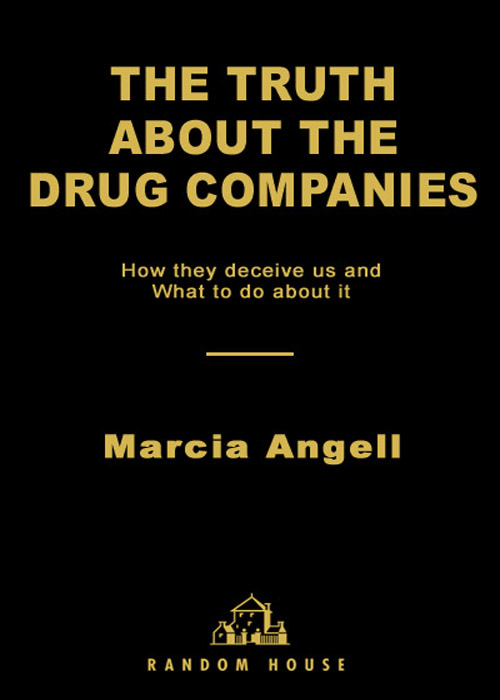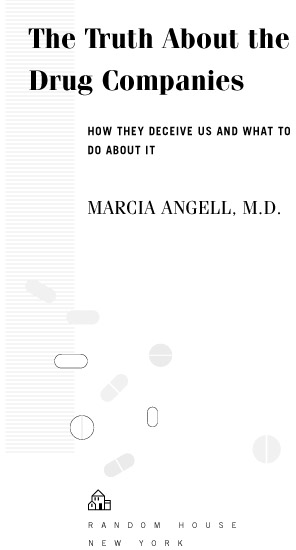Marcia Angell - The Truth About the Drug Companies: How They Deceive Us and What to Do About It
Here you can read online Marcia Angell - The Truth About the Drug Companies: How They Deceive Us and What to Do About It full text of the book (entire story) in english for free. Download pdf and epub, get meaning, cover and reviews about this ebook. year: 2005, publisher: Random House Trade Paperbacks, genre: Business. Description of the work, (preface) as well as reviews are available. Best literature library LitArk.com created for fans of good reading and offers a wide selection of genres:
Romance novel
Science fiction
Adventure
Detective
Science
History
Home and family
Prose
Art
Politics
Computer
Non-fiction
Religion
Business
Children
Humor
Choose a favorite category and find really read worthwhile books. Enjoy immersion in the world of imagination, feel the emotions of the characters or learn something new for yourself, make an fascinating discovery.

- Book:The Truth About the Drug Companies: How They Deceive Us and What to Do About It
- Author:
- Publisher:Random House Trade Paperbacks
- Genre:
- Year:2005
- Rating:3 / 5
- Favourites:Add to favourites
- Your mark:
- 60
- 1
- 2
- 3
- 4
- 5
The Truth About the Drug Companies: How They Deceive Us and What to Do About It: summary, description and annotation
We offer to read an annotation, description, summary or preface (depends on what the author of the book "The Truth About the Drug Companies: How They Deceive Us and What to Do About It" wrote himself). If you haven't found the necessary information about the book — write in the comments, we will try to find it.
Marcia Angell: author's other books
Who wrote The Truth About the Drug Companies: How They Deceive Us and What to Do About It? Find out the surname, the name of the author of the book and a list of all author's works by series.
The Truth About the Drug Companies: How They Deceive Us and What to Do About It — read online for free the complete book (whole text) full work
Below is the text of the book, divided by pages. System saving the place of the last page read, allows you to conveniently read the book "The Truth About the Drug Companies: How They Deceive Us and What to Do About It" online for free, without having to search again every time where you left off. Put a bookmark, and you can go to the page where you finished reading at any time.
Font size:
Interval:
Bookmark:


Contents
To Bud and to Lara and Elizabeth
Introduction: Drugs Are Different
EVERY DAY AMERICANS ARE SUBJECTED to a barrage of advertising by the pharmaceutical industry. Mixed in with the pitches for a particular drugusually featuring beautiful people enjoying themselves in the great outdoorsis a more general message. Boiled down to its essentials, it is this: Yes, prescription drugs are expensive, but that shows how valuable they are. Besides, our research and development costs are enormous, and we need to cover them somehow. As research-based companies, we turn out a steady stream of innovative medicines that lengthen life, enhance its quality, and avert more expensive medical care. You are the beneficiaries of this ongoing achievement of the American free enterprise system, so be grateful, quit whining, and pay up. More prosaically, what the industry is saying is that you get what you pay for.
Your Money or Your Life
Is any of this true? Well, the first part certainly is. Prescription drug costs are indeed highand rising fast. Americans now spend a staggering $200 billion a year on prescription drugs, and that figure is growing at about 12 percent a year (down from a high of 18 percent in 1999). 1 Drugs are the fastest-growing part of the health care billwhich itself is rising at an alarming rate. The increase in drug spending reflects, in almost equal parts, the facts that people are taking a lot more drugs than they used to, that those drugs are more likely to be expensive new ones instead of older, cheaper ones, and that the prices of the most heavily prescribed drugs are routinely jacked up, sometimes several times a year.
Before its patent ran out, for example, the price of Schering-Ploughs top-selling allergy pill, Claritin, was raised thirteen times over five years, for a cumulative increase of more than 50 percentover four times the rate of general inflation. 2 As a spokeswoman for one company explained, Price increases are not uncommon in the industry and this allows us to be able to invest in R & D. 3 In 2002, the average price of the fifty drugs most used by senior citizens was nearly $1500 for a years supply. (Pricing varies greatly, but this refers to what the companies call the average wholesale price, which is usually pretty close to what an individual without insurance pays at the pharmacy.) 4
Paying for prescription drugs is no longer a problem just for poor people. As the economy continues to struggle, health insurance is shrinking. Employers are requiring workers to pay more of the costs themselves, and many businesses are dropping health benefits altogether. Since prescription drug costs are rising so fast, payers are particularly eager to get out from under them by shifting costs to individuals. The result is that more people have to pay a greater fraction of their drug bills out of pocket. And that packs a wallop.
Many of them simply cant do it. They trade off drugs against home heating or food. Some people try to string out their drugs by taking them less often than prescribed, or sharing them with a spouse. Others, too embarrassed to admit that they cant afford to pay for drugs, leave their doctors offices with prescriptions in hand but dont have them filled. Not only do these patients go without needed treatment but their doctors sometimes wrongly conclude that the drugs they prescribed didnt work and prescribe yet othersthus compounding the problem.
The people hurting most are senior citizens. When Medicare was enacted in 1965, people took far fewer prescription drugs and they were cheap. For that reason, no one thought it necessary to include an outpatient prescription drug benefit in the program. In those days, senior citizens could generally afford to buy whatever drugs they needed out of pocket. Approximately half to two-thirds of seniors have supplementary insurance that partly covers prescription drugs, but that percentage is dropping as employers and insurers decide it is a losing proposition for them. At the end of 2003, Congress passed a Medicare reform bill that included a prescription drug benefit scheduled to begin in 2006, but as we will see later, its benefits are inadequate to begin with and will quickly be overtaken by rising prices and administrative costs.
For obvious reasons, senior citizens tend to need more prescription drugs than younger peoplemainly for chronic conditions like arthritis, diabetes, high blood pressure, and elevated cholesterol. In 2001, nearly one in four seniors reported skipping doses or leaving prescriptions unfilled because of the cost. 5 (That fraction is almost certainly higher now.) Sadly, the frailest are the least likely to have supplementary insurance. At an average cost of $1500 a year for each drug, someone without supplementary insurance who takes six different prescription drugsand this is not rarewould have to spend $9000 out of pocket. Not many frail seniors have such deep pockets.
Furthermore, in one of the more perverse of the pharmaceutical industrys practices, prices are much higher for precisely the people who most need the drugs and can least afford them. The industry charges Medicare recipients without supplementary insurance much more than it does favored customers, such as large HMOs or the Veterans Affairs (VA) system. Because the latter buy in bulk, they can bargain for steep discounts or rebates. People without insurance have no bargaining power, and so they pay the highest prices.
In the past two years, we have started to see, for the first time, the beginnings of public resistance to rapacious pricing and other dubious practices of the pharmaceutical industry. It is mainly because of this resistance that drug companies are now blanketing us with public relations messages. And the magic words, repeated over and over like an incantation, are research, innovation, and American. Research. Innovation. American. It makes a great story.
Rhetoric Versus Reality
But while the rhetoric is stirring, it has very little to do with reality. First, research and development (R & D) is a relatively small part of the budgets of the big drug companiesdwarfed by their vast expenditures for marketing and administration, and smaller even than profits. In fact, year after year, for over two decades, this industry has been far and away the most profitable in the United States. (In 2003, for the first time, the industry lost its first-place position, coming in third, behind mining, crude-oil production and commercial banks.) The prices drug companies charge have little relationship to the costs of making the drugs and could be cut dramatically without coming anywhere close to threatening R & D.
Second, the pharmaceutical industry is not especially innovative. As hard as it is to believe, only a handful of truly important drugs have been brought to market in recent years, and they were mostly based on taxpayer-funded research at academic institutions, small biotechnology companies, or the National Institutes of Health (NIH). The great majority of new drugs are not new at all but merely variations of older drugs already on the market. These are called me-too drugs. The idea is to grab a share of an established, lucrative market by producing something very similar to a top-selling drug. For instance, we now have six statins (Mevacor, Lipitor, Zocor, Pravachol, Lescol, and the newest, Crestor) on the market to lower cholesterol, all variants of the first. As Dr. Sharon Levine, associate executive director of the Kaiser Permanente Medical Group, put it, If Im a manufacturer and I can change one molecule and get another twenty years of patent rights, and convince physicians to prescribe and consumers to demand the next form of Prilosec, or weekly Prozac instead of daily Prozac, just as my patent expires, then why would I be spending money on a lot less certain endeavor, which is looking for brand-new drugs? 6
Next pageFont size:
Interval:
Bookmark:
Similar books «The Truth About the Drug Companies: How They Deceive Us and What to Do About It»
Look at similar books to The Truth About the Drug Companies: How They Deceive Us and What to Do About It. We have selected literature similar in name and meaning in the hope of providing readers with more options to find new, interesting, not yet read works.
Discussion, reviews of the book The Truth About the Drug Companies: How They Deceive Us and What to Do About It and just readers' own opinions. Leave your comments, write what you think about the work, its meaning or the main characters. Specify what exactly you liked and what you didn't like, and why you think so.









